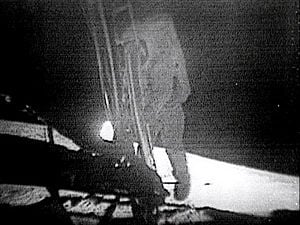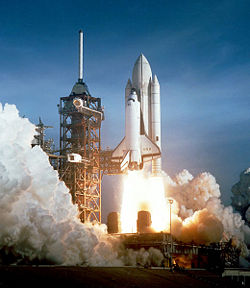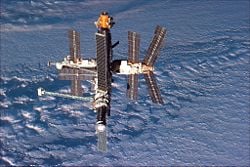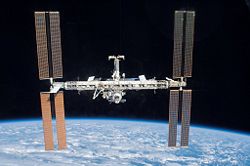Space exploration
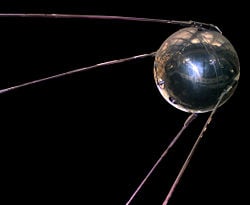
|
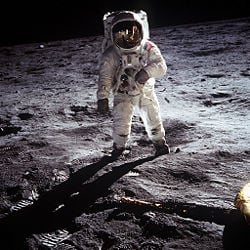
|
| -Top: Sputnik 1, the first man-made satellite in space. -Bottom: Astronaut Edwin Aldrin walks on the surface of the Moon. The Moon is currently the only natural extraterrestrial object that humans have set foot on. |
Space exploration is the physical exploration of outer space, by both human spaceflights and robotic spacecraft. Although the observation of objects in space (that is, astronomy) predates reliable recorded history, space exploration became a practical possibility only after the development of large, liquid-fueled rocket engines during the early twentieth century. Common rationales for exploring space include advancing scientific research, uniting different nations, and ensuring the future survival of humanity.
Space exploration has often been used as a proxy competition for geopolitical rivalries, particularly the Cold War. The early era of space exploration was driven by a space race between the Soviet Union and the United States. The launch of the first human-made object to orbit the Earth, the USSR's Sputnik 1, on October 4, 1957, and the first Moon landing by the American Apollo 11 craft on July 20, 1969, are often taken as the boundaries for this initial period. After the first 20 years of exploration, focus shifted from one-off flights to renewable hardware, such as the Space Shuttle program, and from competition to cooperation, as with the International Space Station. From the 1990s onward, private interests began promoting space tourism. Larger government programs have advocated manned missions to the Moon and possibly Mars sometime after 2010.
Space exploration programs have received various criticisms, on cost or safety grounds, but there are many advocates as well, and public opinion in many countries is usually supportive of these programs. In any case, space missions have resulted in a variety of important discoveries, including the effects of low gravity on humans, the presence of Van Allen belts around the Earth, images of the far side of the Moon, and the absence of intelligent life on Mars. Current discussions revolve around the possibility of space colonization—that is, the establishment of human settlements on extraterrestrial objects.
History
First orbital flights
The first successful orbital launch was of the Soviet unmanned Sputnik 1 (Satellite I) mission on October 4, 1957. The satellite weighed about 83 kg (184 pounds), and is believed to have orbited Earth at a height of about 250 km (150 miles). It had two radio transmitters (20 and 40 MHz), which emitted "beeps" that could be heard by any radio around the globe. Analysis of the radio signals was used to gather information about the electron density of the ionosphere, while temperature and pressure data was encoded in the duration of radio beeps. The results indicated that the satellite was not punctured by a meteoroid. Sputnik 1 was launched by an R-7 rocket. It incinerated upon re-entry on January 3, 1958.
This success led to an escalation of the American space program, which unsuccessfully attempted to launch Vanguard 1 into orbit two months later. On January 31, 1958, the U.S. successfully orbited Explorer 1 on a Juno rocket. In the meantime, the Soviet dog Laika became the first animal in orbit on November 3, 1957.
First humans in space
The first human spaceflight was Vostok 1 (Sunrise 1) , carrying 27 year old cosmonaut Yuri Gagarin on April 12, 1961. The spacecraft completed one orbit around the globe, lasting about 1 hour and 48 minutes. Gagarin's flight was a demonstration of the advanced Soviet space program, and it opened an entirely new era in space exploration: Manned space flights.
The U.S. launched its first man into space within a month of Gagarin's flight, with the first Mercury flight by Alan Shepard. Orbital flight was achieved by the United States when John Glenn's Mercury-Atlas 6 orbited the Earth on February 20, 1962.
Valentina Tereshkova, the first woman in space, orbited the Earth 48 times aboard Vostok 6 on June 16, 1963.
China launched its first taikonaut into space 42 years later, with the flight of Colonel Yang Liwei aboard the Shenzhou 5 (Spaceboat 5) spacecraft.
Some early pioneers of space exploration
The dream of stepping into the outer reaches of the Earth's atmosphere was driven by rocket technology. The German V2 was the first rocket to travel into space, overcoming the problems of thrust and material failure. During the final days of World War II, this technology was obtained by both the Americans and Soviets as were its designers. The initial driving force for further development of the technology was a weapons race for inter-continental ballistic missiles (ICBMs) to be used as long-range carriers for fast nuclear weapon delivery. In 1961, when the USSR launched the first man into space, the U.S. declared itself to be in a "Space Race" with Russia.
- Konstantin Tsiolkovsky, Robert Goddard, Hermann Oberth, and Reinhold Tilling laid the groundwork of rocketry in the early years of the twentieth century.
- Wernher von Braun was the lead rocket engineer for Nazi Germany's World War II V-2 rocket project. In the last days of the war, he led a caravan of workers in the German rocket program to the American lines, where they surrendered and were brought to the America to work on U.S. rocket development. He acquired American citizenship and led the team that developed and launched Explorer 1, the first American satellite. Von Braun later led the team at NASA's Marshall Space Flight Center, which developed the Saturn V moon rocket.
- Initially, the race for space was often led by Sergey Korolyov, whose legacy includes both the R7 and Soyuz—which remain in service to this day. Korolyov was the mastermind behind the first satellite, first man (and first woman) in orbit, and first spacewalk. Until his death, his identity was a closely guarded state secret; not even his mother knew that he was responsible for creating the Russian space program.
- Kerim Kerimov was one of the founders of the Soviet space program and a lead architect behind the the first human spaceflight (Vostok 1), alongside Korolyov. After Korolyov's death in 1966, Kerimov became the lead scientist of the Soviet space program and was responsible for the launch of the first space stations from from 1971 to 1991, including the Salyut and Mir series, and their precursors in 1967, the Cosmos 186 and Cosmos 188.
Other key people included:
- Valentin Glushko held role of Chief Engine Designer for USSR. Glushko designed many of the engines used on the early Soviet rockets, but was constantly at odds with Korolyov.
- Vasily Mishin, Chief Designer working under Korolyov and one of first Soviets to inspect the captured German V2 design. Following the death of Korolyov, Mishin was held responsible for the Soviet failure to be first country to place a man on the Moon.
- Bob Gilruth, was the NASA head of the Space Task Force and director of 25 manned space flights. Gilruth was the person to suggest to President John F. Kennedy that the Americans take the bold step of reaching the Moon in an attempt to reclaim space superiority from the Soviets.
- Christopher C. Kraft, Jr. was NASA's first flight director and oversaw development of Mission Control and associated technologies and procedures.
Some significant discoveries
Effects on humans
The earliest discoveries included the fact that humans could survive in zero gravity. Once the Russians had progressed to flights that were longer than a few hours, space adaptation syndrome appeared; where the sickness and disorientation due to the removal of gravity caused physical symptoms.
In space stations, the effects of zero gravity on bones and skeletal muscles has become more evident, where the human body becomes progressively more optimized for zero-gravity to the extent that return to the Earth becomes problematic and humans become progressively more adapted to the weightless environment.
Earth
Americans were the first to discover the existence of the Van Allen belts around the Earth. These belts contain radiation trapped by the Earth's magnetic fields, which currently prevent habitable space stations from being placed above 1,000 km.
Moon
Russians were the first to take pictures of the far side of the moon, which had never been visible to humans. It was discovered that the far side was somewhat different, more heavily cratered.
U.S. Apollo missions returned rocks from the Moon, supporting the theory that the Moon was once part of the Earth.
Mars
Contrary to fanciful early reports from astronomers viewing Mars, no canals, and certainly no advanced lifeforms are present on the surface of that planet, but the presence of microscopic organisms has not been ruled out.
Space colonization
Space colonization, also called space settlement or space humanization, implies the permanent, autonomous (self-sufficient) human habitation of locations beyond Earth, especially on natural satellites such as the Moon or planets such as Mars. It would rely on significant amounts of In-Situ Resource Utilization.
Many past and current concepts for the continued exploration and colonization of space focus on a return to the Moon as a "stepping stone" to the other planets, especially Mars. Traditional concepts also called for the construction of orbital shipyards for the construction of inter-planetary vessels. Unfortunately, such concepts were prohibitively expensive, with estimated costs of $450 billion or more.
During the 1990s, however, aerospace engineer Robert Zubrin developed the "Mars Direct" plan, emphasizing the utilization of Martian resources. In his widely acclaimed book Mars Direct, Zubrin explained how human beings could be sent to Mars within 10 years, using existing or foreseeable technologies, at a cost of between 20-30 billion dollars.
Other efforts have included the Ansari X Prize, which offered a 10 million dollar prize to any private, non-government organization that could develop a spacecraft capable of launching three human beings into space, returning them safely to Earth, and repeating the feat within 2 weeks. The X-prize was a resounding success with the launch of Space Ship One, which was developed from scratch for only 25 million dollars, a tiny fraction of the cost of a single space shuttle launch. This development was accompanied by other prize incentives, and plans for routine space tourist flights.
Space agencies
Although only the United States, Soviet Union/Russian, and Chinese space programs have launched humans into orbit, a number of other countries have space agencies that design and launch satellites, conduct space research and coordinate national astronaut programs.
Pros and cons
Critics of space exploration usually point out the costs, limitations, and risks of human spaceflight. It is more expensive to perform certain tasks in space by humans rather than by robots or other machines. People need large spacecraft that contain provisions such as a hermetic and temperature-controlled cabin, production of breathable air, food and drink storage, waste disposal, communications systems, and safety features such as crew escape systems and medical facilities. There is also the question of the security of the spacecraft as whole; losing a robot is nowhere near as tragic as human loss, so overall safety of non-human missions is not as much of an issue.
All the extra costs have to be weighed against the benefits of having humans aboard. Some critics argue that those few instances where human intervention is essential do not justify the enormous extra costs of having humans aboard. However, others argue that many tasks can be more effectively accomplished by human beings.
Some, including the late physicist and Nobel prize winner Richard Feynman, have contended that space missions have not achieved any major scientific breakthroughs. However, others have argued that, besides the large (and otherwise unavailable) amount of planetary data returned by spacecraft, there have been many indirect scientific achievements, including development of the modern computer, lasers, and so forth.
The results of research carried out by space exploration agencies, such as NASA, is one of the reasons supporters justify government expenses. Some even claim that space exploration is a necessity to humankind and that staying in its home planet will lead humanity to oblivion. Some of the reasons are lack of natural resources, comets, nuclear war, and worldwide epidemic. Stephen Hawking, renowned British theoretical physicist, said that "I don't think the human race will survive the next thousand years, unless we spread into space. There are too many accidents that can befall life on a single planet. But I'm an optimist. We will reach out to the stars."[1]
Some critics contend that in light of the huge distances in space, human space travel will involve no more than visiting earth's closest neighbors in the Solar System, barring any actualization of the theoretical concept of faster-than-light travel. Even such limited travel would consume large amounts of money and require complex spacecraft accommodating only a handful of people. Supporters of human space travel state that this is irrelevant, because its real value lies in providing a focal point for national prestige, patriotism, and international cooperation. They suggest the Clinton administration's close cooperation with Russia on the International Space Station (ISS) gave Russia something to take pride in, becoming a stabilizing factor in post-communist Russia. From this point of view, the ISS was a justifiable cash outlay.
Some people also have moral objections to the huge costs of space travel, and say that even a fraction of the space travel budget would make a huge difference in fighting disease and hunger in the world. However, compared to much more costly endeavors, like military actions, space exploration itself receives a very small percentage of total government spending (nearly always under 0.5 percent), and space-exploration advocates frequently point out that long-term benefits could outweigh short-term costs. In addition, the successful launches of Space Ship One, a privately constructed, reusable space plane developed for only $25 million, has diminished the impact of cost-based criticisms.
Overall, the public remains largely supportive of both manned and unmanned space exploration. According to an Associated Press Poll conducted in July 2003, 71 percent of U.S. citizens agreed with the statement that the space program is "a good investment," compared to 21 percent who did not.[2] NASA has produced a series of Public Service Announcement videos supporting the concept of space exploration.[3]
This is not to say that space exploration advocates do not criticize existing programs. Some supporters of space explorations, such as Robert Zubrin, have criticized on-orbit assembly of spacecraft as unnecessary and expensive, and argue for a direct approach for human exploration, such as Mars Direct.
Twenty-first century space advocates continue to work towards more advanced spacecraft, rotating space stations, lunar bases, and colonies on Mars. Some of these visions may come true, though significant obstacles remain.
Notes
- ↑ Roger Highfield, Colonies in space may be only hope, says Hawking The Telegraph, October 16, 2001. Retrieved October 14, 2015.
- ↑ Pollingreport.com, Origin of Human Life—USA Today/Gallup Poll. Retrieved December 1, 2007.
- ↑ NASA, NASA "Reach" Public Service Announcement for Space Exploration. Retrieved December 1, 2007.
ReferencesISBN links support NWE through referral fees
- Ball, Andrew J. Planetary Landers and Entry Probes. Cambridge: Cambridge University Press, 2007. ISBN 978-0521820028
- Bond, Peter. Distant Worlds: Milestones in Planetary Exploration. New York, NY: Copernicus Books in association with Praxis Pub., 2007. ISBN 978-0387402123
- Furniss, Tim. A History of Space Exploration: And its Future. London: Mercury, 2005. ISBN 978-1904668152
- Furniss, Tim, David Shayler, and Michael D. Shayler. Praxis Manned Spaceflight Log, 1961-2006. Springer-Praxis Books in Space Exploration. New York, NY: Springer, 2007. ISBN 978-0387341750
- Harland, David M. The Story of the Space Shuttle. London: Springer,2004. ISBN 1852337931
- Harvey, Brian. Space Exploration 2007. Berlin: Springer, 2006. ISBN 978-0387333304
- Jenkins, Dennis R. Space Shuttle: The History of the National Space Transportation System: The First 100 Missions. Cape Canaveral, FL: D.R. Jenkins, 2001. ISBN 0963397451
External links
All links retrieved February 7, 2023.
National agencies
Other sites
- Mars Daily.
- Space Facts.
- Space.com.
- Space Flight Now.
- Space Daily.
- SpaceRef.com.
- Space Today.
- NASA Space Flight.
- NASA Watch.
- Human Space Flight.
- National Space Society. Non-profit organization that promotes a spacefaring civilization.
- Russian Space Web.
- Benefits of Space Exploration. Bibliography from NASA.gov.
- Encyclopedia Astronautica.
Credits
New World Encyclopedia writers and editors rewrote and completed the Wikipedia article in accordance with New World Encyclopedia standards. This article abides by terms of the Creative Commons CC-by-sa 3.0 License (CC-by-sa), which may be used and disseminated with proper attribution. Credit is due under the terms of this license that can reference both the New World Encyclopedia contributors and the selfless volunteer contributors of the Wikimedia Foundation. To cite this article click here for a list of acceptable citing formats.The history of earlier contributions by wikipedians is accessible to researchers here:
The history of this article since it was imported to New World Encyclopedia:
Note: Some restrictions may apply to use of individual images which are separately licensed.
